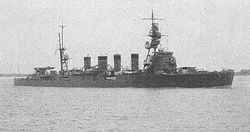Sendai class
|
||||||||||||||
|
||||||||||||||
|
||||||||||||||
|
||||||||||||||
The Sendai class ( Japanese 川 内 型 軽 巡洋艦 , Sendai-gata keijun'yōkan ) was a class of three light cruisers of the Imperial Japanese Navy , which were built in the early 1920s and used in World War II .
history
Design and construction
The Sendai class was almost identical to the previous Nagara class . However, due to four chimneys, the class had a different silhouette than the previous classes. It received a machine system whose twelve boilers were designed for firing with heavy oil , whereby one boiler could also be operated with mixed firing . The boiler with the mixed firing was located in front of the other boilers and had its own chimney. The ships of the class reached speeds of over 35 knots with their four turbines.
With the same dimensions and lower water displacement due to the new propulsion system, the concept of aircraft take-off from the bow with a hangar in the bridge structure was retained. The catapult at the bow of the Nagara-class was replaced by a small departure platform, but later removed to be replaced by a conventional catapult on the quarterdeck.
The armament of the Nagara class with seven 14 cm L / 50 guns, in which the operating crews were protected by shields, two open 8 cm L / 40 guns and two anti - aircraft machine guns was retained, as was their setup.
The torpedo armament consisted of eight torpedoes of the type 93 , distributed over four twin launch tubes.
The armor protection was limited to a belt armor of 6 cm steel and a deck armor of 3 cm steel.
Washington Treaty
The originally planned number of six Sendai-class light cruisers was never reached. The Washington Naval Conference of 1922, which was convened to prevent an arms race at sea similar to that before the outbreak of World War I, limited the overall tonnage for Japanese capital shipbuilding. In order to still be able to build the heavy cruisers of the Furutaka class , which were considered more important, the construction of the Sendai class was stopped after three ships .
List of ships
| Surname | Shipyard | Keel laying | Launch | Commissioning | Whereabouts |
|---|---|---|---|---|---|
| Sendai (川 内 ) | Mitsubishi , Nagasaki | February 16, 1922 | October 30, 1923 | April 29, 1924 | sunk on November 3, 1943 after the sea battle at the Kaiserin-Augusta-Bucht |
| Jintsū (神通 ) | Kawasaki , Kobe | 4th August 1922 | December 8, 1923 | July 31, 1925 | sunk on July 13, 1943 by naval artillery during the sea battle near Kolombangara |
| Naka (那 珂 ) | Mitsubishi, Yokohama | June 10, 1922 | March 24, 1925 | November 30, 1925 | sunk on February 17, 1944 by americans Air raid, during Operation Hailstone |
Sendai
Main article: Sendai (ship, 1923)
The Sendai was laid down in Nagasaki in February 1922 and launched in October 1923. During the Second Sino-Japanese War , it was used to block the Yangtze River . In the Pacific War she was used in the invasion of Malaysia and bombed British positions near Kota Bharu in December 1941 . In November 1942 she took part in the Second Naval Battle of Guadalcanal . A year later she was the flagship of Rear Admiral Ijūin in the naval battle of the Empress Augusta Bay . She was fired at from the darkness by several American cruisers with artillery fire guided by radar location and caught fire. The Sendai eventually had to be abandoned.
Jintsu
Main article: Jintsū (ship, 1925)
The Jintsū was laid down in Kobe in August 1922 and launched in December 1923. During a night exercise in 1927, she rammed a Japanese destroyer and was badly damaged at the bow. At the beginning of the Pacific War in December 1941, she was used as a backup ship for Japanese landings in the Philippines. She took part in the Battle of the Java Sea and in May 1942 in the Battle of Midway . It was damaged by an aerial bomb near Guadalcanal in August 1942. On July 13, 1943, in the Battle of Kolombangara , it was discovered during a night raid by radar from American ships and so badly damaged by artillery fire that it broke and sank.
Naka
Main article: Naka (ship)
The Naka was laid down in Yokohama in June 1922 and was only launched in March 1925 after damage from the Kanto earthquake of 1923. Used in the Pacific War, she was hit by a torpedo from the Seawolf submarine in March 1942 and badly damaged. After repair work, it was used for transport tasks and finally sunk in February 1944 by a torpedo and a bomb hit during an American air raid on Truk .
literature
- Eric LaCroix, Linton Wells: Japanese Cruisers of the Pacific War. US Naval Institute Press, 1997, ISBN 0-87021-311-3 .
Web links
Individual evidence
- ^ Anthony John Watts, Brian G. Gordon: The Imperial Japanese Navy. Doubleday, 1971, ISBN 0-385-01268-3 , p. 134
- ↑ Life, Jan. 2, 1939, Issue 6, No. 1.

